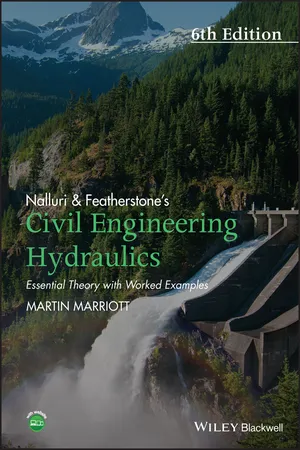
Nalluri And Featherstone's Civil Engineering Hydraulics
Essential Theory with Worked Examples
- English
- ePUB (mobile friendly)
- Available on iOS & Android
Nalluri And Featherstone's Civil Engineering Hydraulics
Essential Theory with Worked Examples
About This Book
An update of a classic textbook covering a core subject taught on most civil engineering courses. Civil Engineering Hydraulics, 6th edition contains substantial worked example sections with an online solutions manual. This classic text provides a succinct introduction to the theory of civil engineering hydraulics, together with a large number of worked examples and exercise problems. Each chapter contains theory sections and worked examples, followed by a list of recommended reading and references. There are further problems as a useful resource for students to tackle, and exercises to enable students to assess their understanding. The numerical answers to these are at the back of the book, and solutions are available to download from the books companion website.
Frequently asked questions
Information
Chapter 1
Properties of Fluids
1.1 Introduction
1.2 Engineering units
1.3 Mass density and specific weight
1.4 Relative density
1.5 Viscosity of fluids

Table of contents
- Cover
- TitlePage
- Copyright
- Preface to the Sixth Edition
- About the Author
- Symbols
- Chapter 1 Properties of Fluids
- Chapter 2 Fluid Statics
- Chapter 3 The kinematics of fluids deals with space
- Chapter 4 Flow of Incompressible Fluids in Pipelines
- Chapter 5 Pipe Network Analysis
- Chapter 6 Pump–Pipeline System Analysis and Design
- Chapter 7 Boundary Layers on Flat Plates and in Ducts
- Chapter 8 Steady Flow in Open Channels
- Chapter 9 Dimensional Analysis, Similitude and Hydraulic Models
- Chapter 10 Ideal Fluid Flow and Curvilinear Flow
- Chapter 11 Gradually Varied Unsteady Flow from Reservoirs
- Chapter 12 Mass Oscillations and Pressure Transients in Pipelines
- Chapter 13 Unsteady Flow in Channels
- Chapter 14 Uniform Flow in Loose-Boundary Channels
- Chapter 15 Hydraulic Structures
- Chapter 16 Environmental Hydraulics and Engineering Hydrology
- Chapter 17 Introduction to Coastal Engineering
- Answers
- Index
- Eula